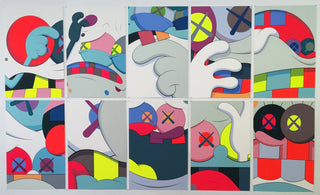
If you’re considering taking the plunge into the world of art investment, or you already have a strong portfolio and you’re looking to invest your capital into more valuable pieces, it’s important you understand what blue-chip art is.
This is what we are going to explore in this blog post. Read on to learn more about blue-chip art, including the meaning of blue-chip art, notable blue-chip artists, and how blue-chip art differs from red-chip art.
In this blog post, we’ll also be providing you with a brief guide to the blue-chip art market, and letting you know how we can help you navigate the blue-chip art market.
Blue-Chip Art Meaning: Where The Name Comes From
The term ‘blue chip’ is borrowed from poker, and then from the stock market. If you have ever played poker, you may be familiar with blue chips - in a game of poker, you may come across white chips, red chips, and blue chips - with blue chips holding the highest value.
Blue chips were used for higher values - with the connotation extending to the stock market in the 1920s. The term was coined by Dow Jones employee Oliver Gingold, who was standing near a stock ticker at a firm (to become Merrill Lynch).
He noticed trades valued at $200 or more a share and mentioned that he was going to return to the office to report the “blue-chip stocks” - and according to Dow Jones folklore, the term was used ever since.
The term references high-quality stocks - referring to high-priced stocks in a reputable and reliable business with a history of generating profit in both good and bad economic times. When investing in stocks, blue-chip stocks are considered an attractive choice as they have a history of success.
Investors typically have high confidence when investing in blue-chip stocks. However, the term ‘blue-chip’ has spread to the world of art investment. Read on to learn more about blue-chip art, including what type of art falls under the category of ‘blue-chip art’.
Blue-Chip Art: A Definition
Just as blue-chip stocks refer to high-quality, reliable stocks with a history of success, blue-chip art refers to quality artwork with verified provenance, created by prominent artists with a solid history of creating artwork that becomes more valuable over time, or at least holds its value.
Blue-chip art typically sells for the highest prices at art auctions/ in auction houses and becomes a valuable investment over time. If you are considering investing in art and expanding your collection, blue-chip art is considered a safe choice.
If an artist has a history of producing art that steadily increases over time, art investors are far more likely to invest in this artist's work - just as they would purchasing stocks from a reputable business with a history of generating profit.
What is Red Chip Art?
Ultimately, red-chip art is the polar opposite of blue-chip art. Although both refer to art that holds great value and potential, red-chip artists have not spent their careers developing a solid reputation in the industry.
Instead, red-chip artists often rise to fame rather quickly - even sometimes overnight. Typically, red-chip artists will use the internet, including social media, to promote their brand or artwork. They may also create digital art and convert them to NFTs. Red-chip art is not traditional, and the value of their artwork is often unpredictable.
Notable Blue-Chip Artists
Now that you have a firm understanding of what blue-chip art is and have a clear definition of the term, let’s discuss some notable blue-chip artists. Blue-chip artists have a solid reputation in the art world, with their artwork having verified provenance.
They have a history of creating valuable art that increases in value. Not all blue-chip artists are actively producing art - the term includes both active artists and retired artists; alive artists and artists that are no longer alive. Some names you’re likely familiar with in the world of blue-chip art include Keith Haring, Pablo Picasso, Andy Warhol, Jean-Michel Basquiat, Claude Monet and many more.
Banksy, the political street artist, is also widely considered a blue-chip artist as he has cemented himself as a prominent name in the industry. If you are looking to invest in Banksy prints, you can do so here at Grove Gallery. Check out this blog outlining Banksy’s most famous art.
A Guide to The Blue Chip Art Market
If you are considering purchasing blue-chip art, whether it be to add to your collection or to invest your hard-earned capital, it’s important to know where you can invest in blue-chip art.
Blue-chip artworks can be purchased at auction houses and through art galleries, as well as prestigious art fairs. The value of art has been increasing for a number of years - with the Artprice Global Index stating that the value of art has increased by 30% in the last 20 years.
This suggests that now is the time to make an investment. Blue-chip art investment is a long-term investment - profit could potentially build over several decades. Knowing where to invest can be just as important as which art you invest in - this is something we can help with at Grove Gallery.
At Grove Gallery, we are home to an impartial art advisory service. We can guide you through the world of art investment, guiding you on not only the best artists for your budget but the best time to buy a piece of art.
Likewise, you can browse the pieces of art we have on display at Grove Gallery, from blue-chip artists such as Pablo Picasso, Andy Warhol, Joan Miro and Marc Chagall.
We are your go-to for purchasing luxury blue-chip artwork; if you are looking to expand your collection and purchase luxury art, contact our team of specialists today.
You can invest a minimum of £5,000 with Grove, with short, medium and long-term investment options. Growth rates can vary between 4.20% and 11.30% - making Grove Gallery a great place to invest in art.






